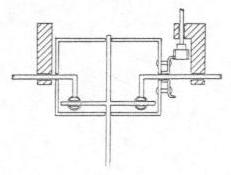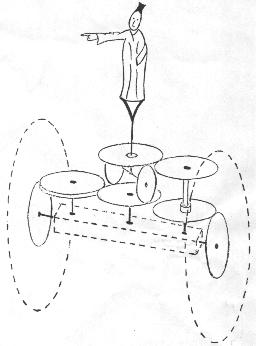| But, why universal joints at all ? Building on oscillating coupling
rods we get down to Two gears as well, which are necessary
only to get "round the corner" to the pointer. Sr. R.G. Torrent entered
this idea, but failed to implement it.
Explanation: If both halfshafts in the picture to the left rotate at
the same speed, but in opposite direction, the "cross" in the middle will
move up and down while swinging round the vertical axis. If the speeds
differ, the "box" guiding the up and down movement will have to rotate.
For the chariot you will need two of these assemblies - one to reverse
the rotation of one roadwheel ("box" fixed to frame !) and one with rotatable
box as depicted to extract the motion for the pointer (vertical axis to
the upper right). |
 |



